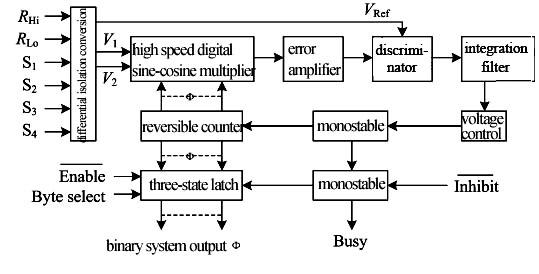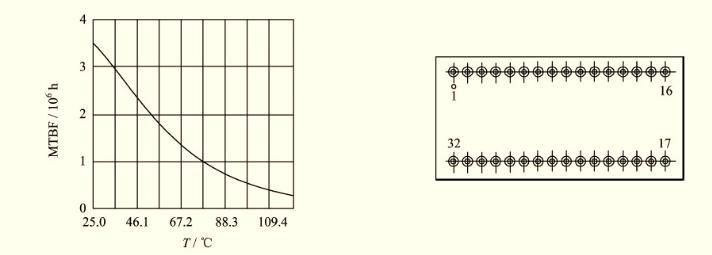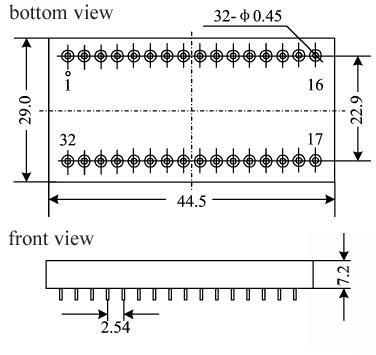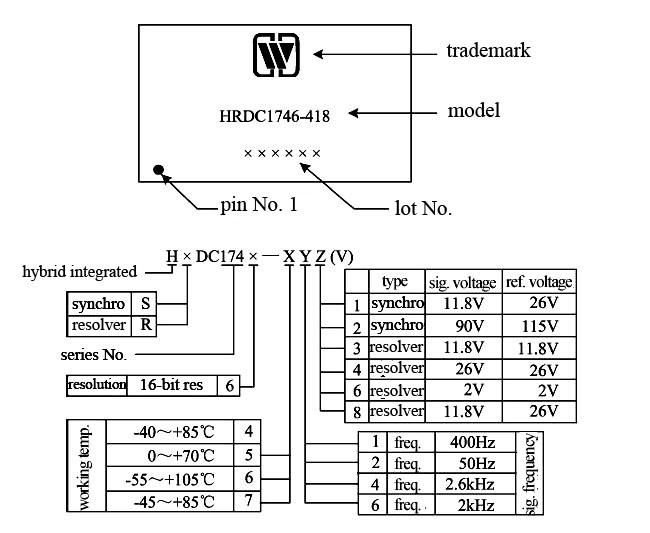|
Internal differential isolation conversion |
 |
|
Resolution: 16 bits |
|
|
Three-state latch output |
|
|
Uninterrupted tracking during data transfer |
|
| 32-wire metal package |
|
Table 2 Rated conditions and recommended operating conditions |
|
Table 3 Electricalcharacteristics |
||||
|
Absolute max. rated value |
Supply voltage Vs: ± 17.25VDC |
|
Parameter |
HSDC/HRDC 1746 Series |
Notes |
|
|
Logical supply voltage VL: +7V |
|
|||||
|
Storage temperature range: -55℃~150℃ |
|
Min. |
Max. |
|||
|
Recommended operating conditions |
Supply voltage Vs: ±15± 5% |
|
Accuracy/angular minute |
-2.6 |
2.6 |
|
|
Effective value of reference voltage VRef: ±10% of nominal value |
|
Tracking speed: rps |
-3 |
3 |
|
|
|
Effective value of signal voltage V*I: Nominal value ±5% |
|
Resolution/bit |
16 |
|
|
|
|
Frequency f*of reference signal: nominal value ±10% |
|
Signal and reference frequency/Hz |
50 |
2.6k |
|
|
|
Phase shift between signal and excitation:<±10% |
|
Signal voltage (effective value)/V |
2 |
90 |
|
|
|
Range of operating temperature (TA): -40~+105℃ |
|
Reference voltage (effective value)/V |
2 |
115 |
|
|


|
(1) Dynamic characteristics |
 |
|
Transfer function of the converter is shown in Fig. 3: Open-loop gain: Closed-loop function: 
|
|
| For the module of this model Ka=48000/S2, T1=7.1ms, T2=1.25ms |
Fig. 3 Function transfer of the converter |
 |
|
|
Fig 4 Time sequence of 16-bit bus transfer
Fig5 Time sequence of 8-bit bus transfer |
6. MTBF curve (Fig. 6) of Synchro to Digital Converters or Resolver to Digital Converters (HSDC/HRDC1746 Series) |
7. Pin designation (Fig.7, Table 4) of Synchro to Digital Converters or Resolver to Digital Converters (HSDC/HRDC1746 Series) |
 |
|
|
Fig.6 MTBF-temperature curve |
Fig.7 Pin designation (Bottom view) |
|
(Note: as per GJB/Z299B-98, envisaged good ground condition) |
|
|
Pin |
Symbol |
Meaning |
Pin |
Symbol |
Meaning |
|
1 |
NC |
No connection |
17 |
NC |
Leave unconnected |
|
2 |
D9 |
Digital output for 9thbit |
18 |
RHi |
Input of Resolver RHi |
|
3 |
D10 |
Digital output for 10thbit |
19 |
RLo |
Input of Resolver RLo |
|
4 |
D11 |
Digital output for 11thbit |
20 |
GND |
Ground |
|
5 |
D12 |
Digital output for 12thbit |
21 |
-VS |
-15V power supply |
|
6 |
D13 |
Digital output for 13thbit |
22 |
+ VS |
+15V power supply |
|
7 |
D14 |
Digital output for 14thbit |
23 |
Inhibit |
Control of data locking |
|
8 |
D15 |
Digital output for 15thbit |
24 |
D1 |
Digital output for 1st bit |
|
9 |
D16 |
Digital output for 16thbit |
25 |
D2 |
Digital output for 2nd bit |
|
10 |
Enable |
Control of chip select Enable |
26 |
D3 |
Digital output for 3rd bit |
|
11 |
Bysel |
Byte select |
27 |
D4 |
Digital output for 4th bit |
|
12 |
S4NC① |
S4input/no connection |
28 |
D5 |
Digital output 5th bit |
|
13 |
S3 |
S3 Input |
29 |
D6 |
Digital output 6th bit |
|
14 |
S2 |
S2 Input |
30 |
D7 |
Digital output 7th bit |
|
15 |
S1 |
S1 Input |
31 |
D7 |
Digital output 8th bit |
|
16 |
NC |
No connection |
32 |
NC |
No connection |





|
Case model |
Header |
Header plating |
Cover |
Covering plating |
Pinmaterial |
Pin plating |
Sealing style |
Notes |
|
UP4529-32a |
Kovar (4J29) |
Ni |
Iron/ nickel alloy (4J42) |
Ni |
Kovar (4J29) |
Ni/Au |
Matchedseal |
|


 X
X